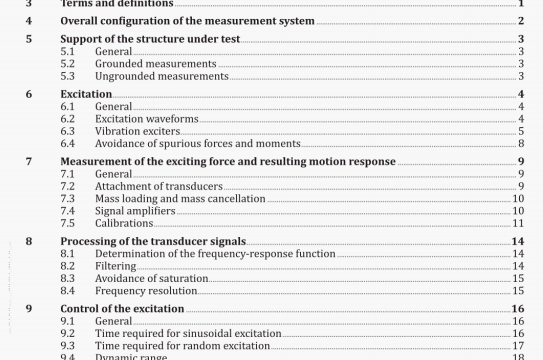ISO 07626-2 pdf download – Mechanical vibration and shock —Experimental determination ofmechanical mobility – Part 2: Measurements using single-point translation excitation with an attached vibration exciter.
6.2.3 Slowly swept sinusoidal excitation
The excitation for a given measurement Is a sinusoidal signal continuously swept in Frequency from the lower to the upper limit of the frequency range of interest. The rate at which the frequency is swept shall be slow enough to achieve quasi-steady-state response of the structure; requirements for selecting the sweep rate are given in 9.22. Over a small interval of time, the energy of excitation is concentrated In the small frequency band swept during that interval.
6.2.4 Stationary random excitation
The waveform of stationary random excitation has no explicit mathematical representation, but does have certain statistical properties. The spectrum of the excitation signal shall be specified by the spectral density of the exciting force. Recommendations for shaping the spectral density to concentrate the excitation in the frequency range ollnterest are given In 9.4.3. All vibration modes having frequencies within this frequency range are excited simultaneously.
6.2.5 Other excItation waveforms
6.2.5.1 General
Additional types of waveforms, described in 6.2.5.2 to 6.2.5.5. also simultaneously excite all vibration modes within a frequency band of Interest. The methods of signal processing and excitation control used in conjunction with these waveforms are similar to those used with stationary-random excitation. These waveforms are repetitive and are recommended when synchronous time-domain averaging of the response waveform Is necessary to measure properly the motion response of the structure.
6.2.5.2 Pseudo-random excitation
The excitation signal is synthesized digitally in the frequency domain to attain a desired spectrum shape. An inverse Fourier transformation of the spectrum may be performed to generate repetitive digital signals which are then converted to analogue electrical signals to drive the vibration exciter.
6.2.5.3 Periodic-chIrp excitation
A periodic chirp is a rapid repetitive sweep of a sinusoidal signal in which the frequency is swept up or down between selected frequency limits. The signal may be generated either digitally or by a sweep oscillator and should be synchronized with the signal processor for waveform averaging to improve the signal-to-noise ratio.
6.2.5.4 PeriodIc-Impulse excitation
A suitably shaped impulse function, usually generated digitally, is periodically repeated. The signal processor should be synchronized with the signal generator. The impulse function shape (typically half- sine or decaying step functions) shall be chosen to meet the excitation frequency requirements.
6.2.5.5 Periodic-random excitation
A periodic-random excitation combines the features ofstationary random and pseudo-random excitation in that it satisfies the conditions for a periodic signal and yet changes with time so that it excites the structure in a random manner; this is done by usingdif lerent pseudo-random excitation for each average.
6.3 Vibration exciters
Devices commonly attached to the structure under test to apply input forces having desired waveforms include electrodynamic, electrohyd raulic, plezoelectric. and rotating eccentric mass vibration exciters. The frequency ranges of general applicability for each type of exciter are shown in Figure 2.
7.3 Mass loading and mass cancellation
As outlined in 6.4.2, the amount of mass added to a structure for test purposes shall be minimized. When testing lightweight structures, it is desirable to compensate electronically for the total effective mass, m1, of the transducers and attachment hardware at the driving point of the structure. Electronic compensation for this mass shall be considered when the magnitude of the driving-point mobility of the structure being tested is greater than O,O1/fmt at all frequencies,f in hertz, within the frequency range of Interest; the mass, me. in kilograms. is the sum of the mass of the hardware used to attach the force transducer to the structure being tested and the effective end mass of the force transducer or impedance head as defined in ISO 7626-1.
If the above criterion cannot be met, the following compensation procedure, commonly known as ‘mass cancellation. may be considered, The acceleration signal at the point of excitation is obtained and multiplied, either in an analogue circuit or digitally, by the total effective mass to be compensated. The product represents that part of the exciter output force which is required to accelerate the effective mass added to the structure for the purpose of carrying out the test. This force signal is subtracted, either in an analogue circuit ordigitally. from the force transducer signal to obtain the net exciting force acting on the structure under test.
ISO 07626-2 pdf download – Mechanical vibration and shock —Experimental determination ofmechanical mobility – Part 2: Measurements using single-point translation excitation with an attached vibration exciter
